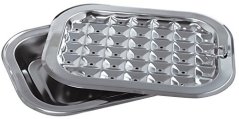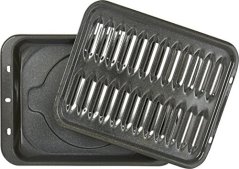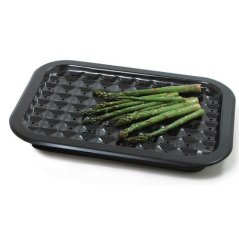Buying guide for Best broiler pans
A broiler pan can be an integral part of your culinary arsenal. Once upon a time, a broiler pan came with every oven bought. While this isn’t always the case anymore, a broiler pan is still a highly effective cookware component that should be a part of your kitchen.
Broiler pans, simply put, broil. While typically used to broil meat, they can also be used to prepare a wide range of other foods. Some cooks even use them for baking. Because they require less oil than some other cooking methods, they are usually a healthier cooking option. What’s more, due to the fact that they can withstand higher heat, they also offer a faster way to cook foods.
While fairly simple in design, there are a variety of features to consider when shopping for a broiler pan. In this guide, we cover everything from size and heat resistance to features and price. We also offer a variety of our favorite pans and explain why we feel they rise above the competition.
Key considerations
Number of pieces
The classic configuration for a broiling pan is a two-piece set consisting of a broiling rack or pan (with holes or vents to drain juices) and a drip pan to collect the grease and juices. The majority of broiler pans adhere to this two-piece configuration, although there are a few sets containing three pieces or, on occasion, a single piece.
Heat resistance
Of all the heat sources on your stove, the broiler will usually be the hottest. As such, broiler pans are designed to withstand a significant amount of heat. Heat tolerance can vary from pan to pan, so you should definitely check any included use instructions (or contact the manufacturer) for information before using the pan.
Broiler pans with a high heat resistance will be much more versatile, while those with a lower heat resistance may develop cracks in their coating or even warp if exposed to too much heat.
Size
Broiler pans are made in a variety of sizes. Some are designed to fit specific oven brands and models; others are designed for specific oven sizes (like a toaster oven). Notably, a broiler pan not specifically designed for your oven will still work in your oven if it fits. If you have a lower compartment broiler and wish to find a pan that fits it, perform a brand/model search for one, or measure the width and depth of the broiler carefully for pan dimensions.
If you simply want a broiler pan for use with an oven-based broiler, you should still measure your oven’s interior width and depth to verify the pan you’re considering would fit. Note that while a larger broiler pan can hold more food, it might be overkill for a single person or couple. Larger broiler pans can also be harder to clean, and they take up more storage space in your kitchen.
Chemical-free
For the healthiest cookware, seek a broiler pan free from harmful chemicals that could leach into the food you’re cooking. Check with the manufacturer to verify that a pan does not contain FPOA, PTFE, and other potentially harmful chemicals.
Expert tip
If you’re like me and keep your broiler pan in the bottom of your oven, wash it monthly, even if you don’t use it. Items can drop on it, causing the pan to accumulate stains and unsanitary food drips.
BestReviews Cooking and Baking Expert
Ease of cleaning
Broiling can be a messy job. While you can cut down on a large amount of grease and burnt-on problems by using aluminum foil, you may still face a challenging cleanup. Some broiler pans can be run through the dishwasher, while others should be washed by hand. (Check the manufacturer’s recommended cleaning method to know for sure.) Washing by hand is usually accomplished with a cloth and warm, soapy water, but you can upgrade to a soft scrubber for stuck-on stains. Some broiling pans also feature a nonstick surface, which can greatly cut down on cleaning chores post-meal.
Features
Materials
While broiler pans can be made from aluminum and other materials, stainless steel is the most common pan material. Some broiling pans feature a carbon steel core sandwiched between layers of aluminum, which can help it to heat faster and more evenly.
Whatever your broiling pan is made of, inspect it carefully when it first arrives. Some pans have sharp edges that could really slice up your hands when you’re cooking or cleaning them.
Finish
The majority of broiling pans have a nonstick or enameled finish to help make cooking and cleanup easier and to protect the pan. Choose a pan with a finish that is not known to wear down, chip, or scratch.
Broiling pan component
The upper pan that sits atop the drip pan is technically the broiling pan. It holds the food you are cooking and usually has perforations or vents that allow grease and other juices to flow away from whatever you’re cooking. While a solid pan with vents is more common, some broiling pans are wire racks that sit inside a drip pan.
Expert tip
If your broiler pan takes up too much space in your oven, consider keeping it in your warming drawer (if your range has one).
BestReviews Cooking and Baking Expert
Drip pan component
The other major component of a broiler pan is the drip pan. It should be deep enough to hold all meat drippings and keep them away from the meat as you broil it. The majority can double as roasting pans.
Handles
While rare, some broiling pans have handles. The handles may be made of a stay-cool material or at least a material that stays cooler than the pan itself. Handles can be very helpful when you’re moving a hot broiler pan from one place to another. For safety, the handles should be securely riveted to the pan.
"A standalone broiler pan may be the perfect choice if you wish to add one to a stove that doesn’t have a pan or upgrade an existing pan."
STAFF
BestReviews
Broiling pan prices
Broiling pans start out around $10 and can reach up to $35 or so. The average price for these pans is $20-$25.
Inexpensive
Packs of disposable aluminum foil broiler pans start around $10. You might also find a small or less-durable broiler pain from $10 to $20.
Mid-range
In the $20 to $25 range, you will find the majority of broiling pans. Some are standalone pans; others are designed to fit oven broilers. Pans in this range are usually made from stainless steel with a porcelain or nonstick coating.
High-end
Broiler pans that cost greater than $25 tend to have a better build quality. Some consist of a carbon steel core for even heating.
Expert tip
When cleaning your broiler pan, soak, then scrub. If you go to town on it with steel wool before soaking, it can scratch and take a lot longer to clean.
BestReviews Cooking and Baking Expert
Tips
- Pay special attention to name-brand pans and pans designed for specific types of ovens. These will often only fit specific models or sizes of ovens.
- Some broiler pans are nonstick; others are not. To keep food from sticking, you can brush a little butter or oil on the surface of the pan before adding your food.
- Avoid placing your broiler pan too close to the heating element. Otherwise, you might overcook or even burn your food. This holds particularly true for compact broiler pans.
- Examine drainage slots or holes before making a purchase. Slots and holes should be designed so food cannot easily fall through and grease does not easily clog them.
- Consider disposable broiling pans. Made from a thick aluminum foil, disposable broiler pans are often sold in multipacks of 10, 25, or more.
- Note that heat resistance varies from pan to pan. Find out exactly how heat-resistant a broiler pan is before you use it.
FAQ
Q. Can I use aluminum foil on a broiling pan?
A. Aluminum foil is actually quite effective when you reach the clean-up stage of a meal. It is commonly used to line the grease-catching drip pan, but some cooks also use it on the vented broiler pan to cut down on clean-up time. If you place aluminum foil on the vented broiler part of the pan, cut slots in the foil to allow grease and other juices to drain properly.
Q. My broiler pan has high and low settings. What is the best way to use a broiler pan under each one?
A. A broiler pan with high and low settings allows you to broil foods at two different temperatures. Some cooks will only ever use the high broiler setting, and there is nothing wrong with that. If you really want to kick your broiling up a level, however, you should be aware of what each setting can do.
High settings are best for foods that fare well with fast heating, such as vegetables. A high setting is also a great way to cook thin slices of meat and meat that you prefer on the “rare” side. Low settings are best for slow-cooking thicker cuts of meat and meat you prefer to be well-done but not too dry.
Q. Can I fully cook food with a broiler pan?
A. Some foods, such as vegetables and thinner cuts of meat, will fully cook on a broiler pan with no problem. As a broiler essentially sears the outside of foods to cook them, larger and thicker cuts of meat may be more problematic. One way to overcome this problem is to pre-cook the meat in the oven and finish it off under the broiler.



















